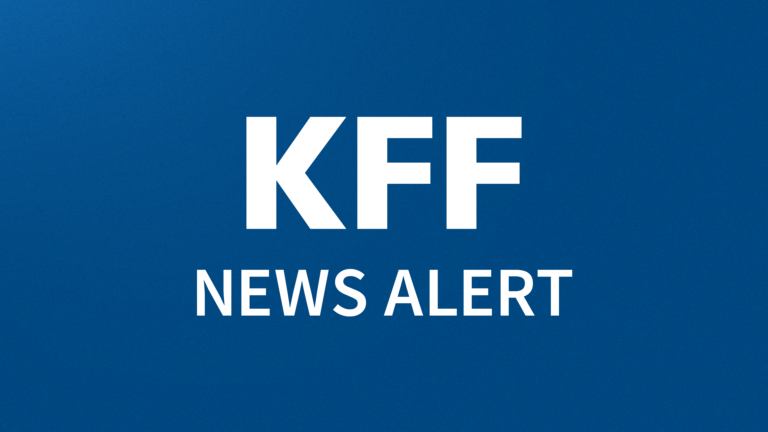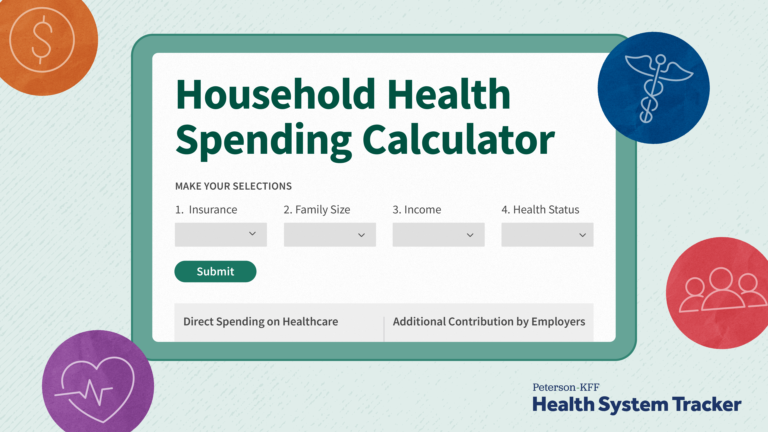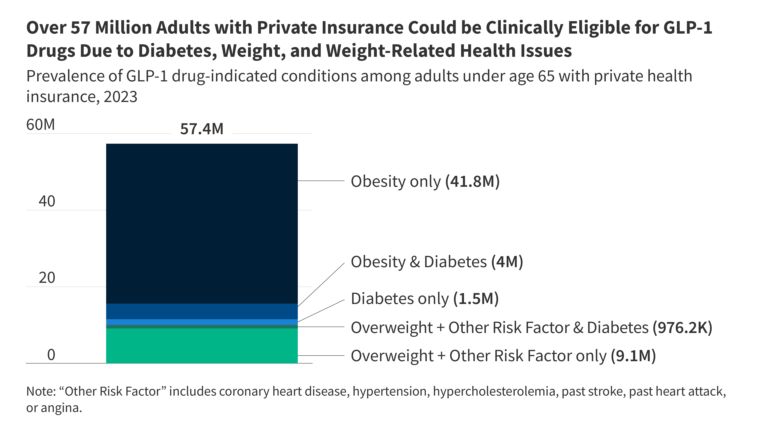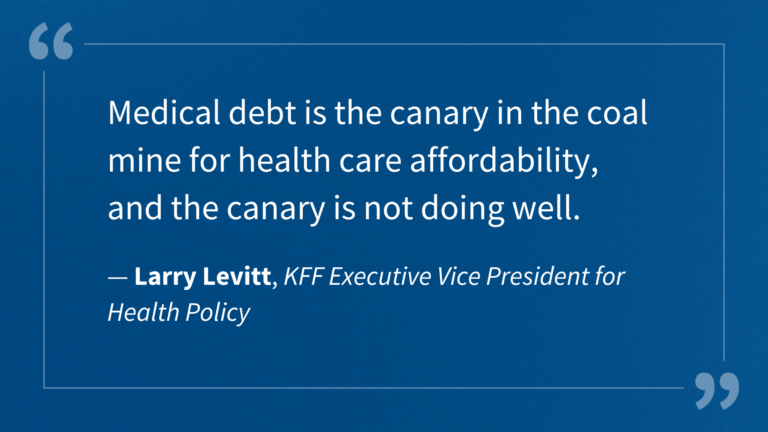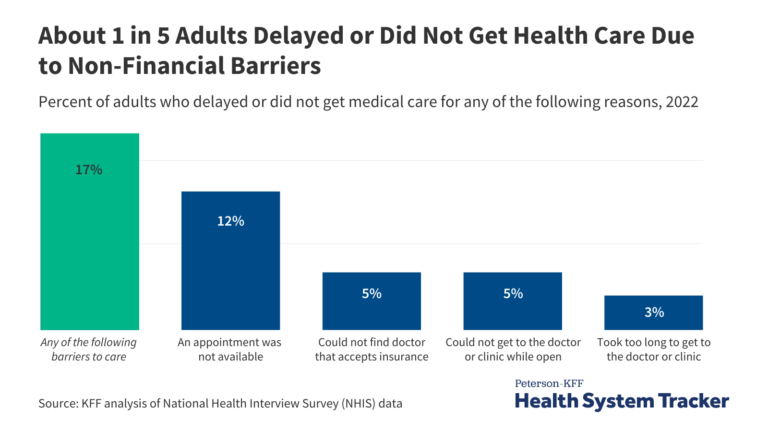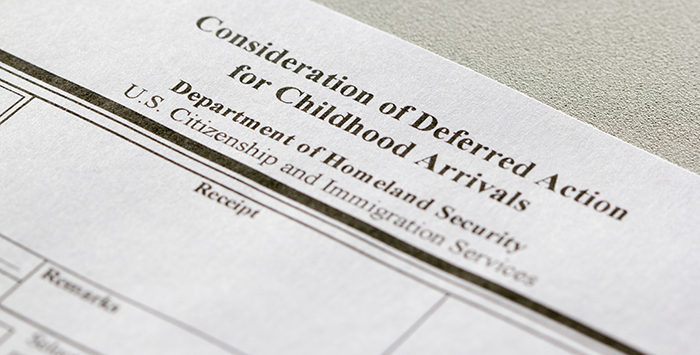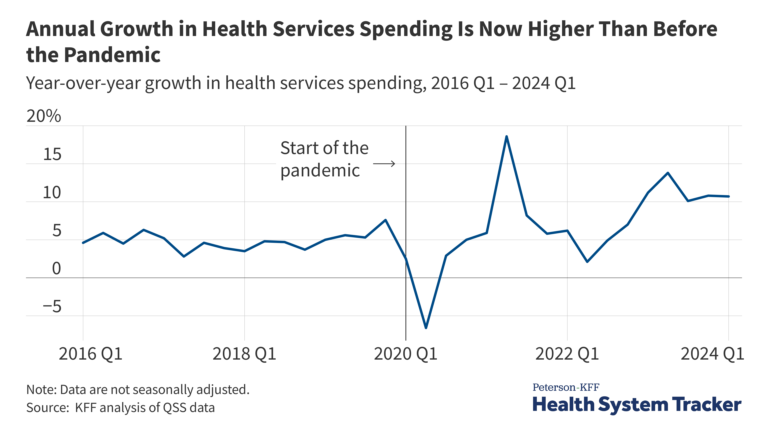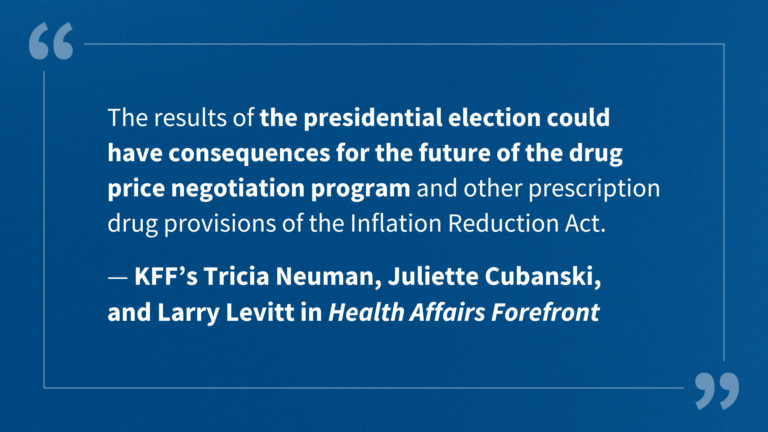This brief was revised in August 2024 to incorporate developments in the Drug Price Negotiation Program since the August 2023 edition, including the announcement of negotiated prices for the initial round of selected medications.
The Inflation Reduction Act of 2022 (the Act), signed by President Biden in August 2022, includes various provisions aimed at reducing prescription drug costs for Medicare beneficiaries and lowering federal drug spending. A central feature of the Act mandates the Secretary of Health and Human Services (HHS) to engage in price negotiations with pharmaceutical companies for specific drugs covered under Medicare Part D (starting in 2026) and Part B (beginning in 2028). This new directive follows years of legislative debate regarding granting the federal government the authority to negotiate drug prices in Medicare, which coincides with the filing of numerous lawsuits aimed at obstructing this initiative. On August 15, 2024, CMS revealed negotiated prices for the list of 10 Part D drugs earmarked for negotiation.
This FAQ section draws from CMS’s guidance for the inaugural year of the Medicare drug price negotiation program and the statutory framework of the Act. It addresses queries regarding the new negotiation program and CMS’s implementation approach, particularly focusing on details relevant for 2026:
Which drugs were chosen for price negotiation for 2026?
For 2026, CMS has selected 10 Part D drugs for negotiation with manufacturers. The list of these 10 drugs was published in August 2023. The selected drugs span various medical conditions, including diabetes (Farxiga, Fiasp/NovoLog, Januvia, Jardiance), blood clots (Eliquis, Xarelto), heart failure (Entresto, Farxiga), psoriasis (Stelara, Enbrel), rheumatoid arthritis (Enbrel), Crohn’s disease (Stelara), and blood cancers (Imbruvica) (Refer to Table 1).
The scope of drugs subject to price negotiation will expand in forthcoming years: 15 Medicare Part D drugs for 2027, another 15 drugs covered under Medicare Part D or Part B for 2028, and an additional 20 drugs covered under Part D or Part B from 2029 onwards. The total number of drugs with negotiated prices will accumulate over time.
(Back to top)
What was the result of the first round of price negotiation for 2026?
On August 15, 2024, CMS announced the negotiated prices for the initial 10 drugs selected for negotiation. These prices will become effective for Medicare beneficiaries on January 1, 2026. According to CMS, had the negotiated prices for these 10 drugs been implemented in 2023, Medicare would have saved $6 billion, equating to net savings of 22% on these medications. Additionally, Medicare beneficiaries are estimated to save $1.5 billion when these negotiated prices are enforced in 2026.
CMS will release an explanation of the negotiated prices for the first 10 selected drugs by March 1, 2025, detailing factors considered during the negotiation process, including manufacturer-specific financial data and evidence on the clinical benefits of the selected drugs compared to alternatives.
(Back to top)
Which drug types are eligible for price negotiation in 2026?
Drugs eligible for price negotiation in 2026 must be covered under Medicare Part D, specifically being single-source brand-name drugs or biological products without therapeutic equivalents that are marketed bona fide (defined below). Additionally, a drug must be at least 7 years (for small-molecule drugs) or 11 years (for biologics) past its FDA approval date by the time the negotiation list is published. In practice, for a single-source drug to qualify for negotiation in 2026, it must have been approved by September 1, 2016, and a biological product must have been licensed by September 1, 2012. For drugs with multiple FDA approvals, CMS uses the earliest approval date to determine eligibility.
Qualifying ‘single source drug’ definitions exclude certain drugs: (1) drugs marked for a single rare disease or condition (the orphan drug exclusion); (2) drugs with combined total spending under Part D and Part B of less than $200 million (using data from June 1, 2022, to May 31, 2023, for the 2026 evaluation); and (3) plasma-derived products. Furthermore, for the years 2026 to 2028, the Act makes exceptions for certain “small biotech” drugs (details outlined below).
According to CMS, if a drug is designated for multiple rare diseases or conditions, it will not qualify for the orphan drug exclusion, even if it is not approved for those additional indications. CMS will consider only active designations and approvals in these evaluations.
(Back to top)
How did CMS choose the 10 drugs for price negotiation for 2026?
The 10 Part D drugs chosen for price negotiation in 2026 were derived from the top 50 negotiation-eligible Part D drugs with the highest total Medicare Part D expenditures. Total expenditures are defined as overall gross covered prescription drug costs. To establish this ranking, CMS first identified the qualifying single-source drugs among the covered Part D drugs, applying relevant statutory exclusions (as mentioned earlier). It then calculated total expenditures for each qualifying drug, leveraging spending data from the year spanning June 1, 2022, to May 31, 2023. The top 50 drugs with the highest total expenditures from that time frame were designated for negotiation eligibility in 2026.
Under the Inflation Reduction Act, a delay in drug selection for negotiation is permitted if they are biological products with a “high likelihood” of biosimilar market entry within two years of the publication date of the selected drug list (elaboration below). Consequently, CMS initially removed any biological products that could qualify for delayed selection before determining the 10 highest-ranked Part D drugs. However, no such biological drugs met the criteria for a delayed selection based on potential biosimilar entries.
(Back to top)
What is the timeline for key activities under the Medicare drug price negotiation program for 2026?
For the 10 selected Part D drugs whose negotiated prices will take effect in 2026, Figure 1 outlines a timeline of critical dates and activities related to the negotiation process.
(Back to top)
What is the timeline for key activities under the Medicare drug price negotiation program for 2027?
CMS will announce the next set of 15 Part D drugs selected for negotiation by February 1, 2025. The negotiation for these drugs will commence on February 28 and conclude on November 1. CMS will unveil maximum fair prices for these drugs by November 30, 2025, with negotiated prices coming into effect on January 1, 2027.
(Back to top)
How will CMS evaluate the availability of generics or biosimilars?
The presence of a bona fide marketed generic or biosimilar for any strength or dosage form of a drug will disqualify that drug from being considered as a qualifying single-source drug. In evaluating whether a potential qualifying drug may be disqualified based on the existence of a marketed generic or biosimilar, CMS will leverage information from diverse sources.
CMS will consult FDA references to ascertain if a generic or biosimilar has received approval. To assess whether generic or biosimilar equivalents were available and marketed bona fide for potential qualifying single-source drugs in 2026, CMS analyzed Part D claims data from August 16, 2022, to August 15, 2023, alongside Average Manufacturer Price (AMP) data from August 1, 2022, to July 31, 2023, to gauge utilization and sales of generics or biosimilars.
According to CMS guidance, the determination related to bona fide marketing will not strictly adhere to a quantitative definition; it will assess the overall circumstances. This includes examining sales data, availability for purchase, and any manufacturer agreements that might limit the drug’s market presence. CMS will perform ongoing evaluations to affirm that “meaningful” competition exists and that marketing practices are bona fide.
(Back to top)
What is the Small Biotech Exception?
In the years 2026 through 2028, the Inflation Reduction Act specifies that “small biotech” drugs will be exempt from negotiation. To qualify for the “Small Biotech Exception” in 2026, total Part D expenditures for the drug in 2021 must comprise 1% or less of total Part D expenditures across all covered drugs, and 80% or more of total expenditures under Part D for all of the manufacturer’s drugs with a Coverage Gap Discount Program agreement in 2021. CMS will handle these calculations.
Manufacturers requesting consideration for this exception must provide information regarding their products to CMS. For 2026, requests for exceptions were due by July 3, 2023 to allow CMS to determine qualifying drugs before the September 1, 2023, publication date of selected drugs for that year. For 2026, CMS identified four drugs that qualified for the Small Biotech Exception based on the information submitted by their manufacturers.
Manufacturers desiring consideration for this exception for subsequent years must resubmit their requests, as CMS’s decisions regarding the Small Biotech Exception for 2026 will not carry over.
(Back to top)
What is the Biosimilar Delay?
The Inflation Reduction Act allows for a delay in selecting drugs for negotiation if they are biological products where a “high likelihood” of biosimilar entry exists within two years of the publication date of the selected drug list. For 2026, this means that licensure and marketing of a biosimilar must be highly likely to occur before September 1, 2025. This delay aims to avoid creating financial incentives that might hinder biosimilars’ market entry if a reference product (the original biological product against which a proposed biosimilar is compared) is selected for negotiation at a price lower than potential competitor biosimilars.
To evaluate a delay request, the manufacturer of the biosimilar must submit documentation to CMS by the selected drug publication date. The biosimilar manufacturer must differ from the reference product manufacturer, and no agreements should exist between them that limit the biosimilar’s market presence in the U.S. Manufacturers will not know if the reference product will be selected for negotiation when submitting requests, but CMS will ignore requests if the reference product isn’t selected. The deadline for submitting biosimilar delay requests for 2026 was May 22, 2023.
CMS will assess whether there’s a likelihood of biosimilar entry based on two criteria: (1) whether a biosimilar licensure application has been accepted or approved by FDA (no later than August 15, 2023, for the 2026 negotiation year), and (2) “clear and convincing” proof that the biosimilar will reach the market within two years post-publication of the selected drug list, ensuring no patent barriers impede entry.
For 2026, CMS confirmed no biological products would have been selected for negotiation but for successful delay requests.
(Back to top)
What factors does CMS consider when negotiating the maximum fair price for selected drugs?
The Inflation Reduction Act mandates CMS to take into account specific manufacturer-related factors and information regarding therapeutic alternatives in its negotiations to establish the “maximum fair price” for selected drugs, though it does not prescribe how to weigh these elements in formulating its offer.
Manufacturer-specific factors relevant to selected drugs include:
- Research and development costs and the extent they have been recouped.
- Current production and distribution unit costs.
- Federal financial backing for novel therapeutic discovery and development related to the drug.
- Data on pending and approved patent applications and exclusivities.
- Market data, including revenue and sales volume data in the U.S.
For the 10 Part D selected drugs in 2026, these data requirements must be provided to CMS by October 2, 2023.
Information about therapeutic alternatives includes:
- The degree to which the selected drug represents a therapeutic improvement over existing alternatives and their relative costs.
- Prescribing information for the selected drug and its therapeutic counterparts, including generics or biosimilars.
- Comparative effectiveness of the selected drug against its therapeutic alternatives, reflecting on specific populations (e.g., individuals with disabilities, the elderly, terminally ill, children).
- The extent to which the selected drug and alternatives address unmet medical needs.
CMS guidance states submissions concerning these factors may come from various entities, such as selected drug manufacturers, other drug makers, Medicare recipients, academic experts, clinicians, etc. All submissions were due by October 2, 2023, for the selected drugs in 2026. In addition to analyzing submitted information, CMS will review existing literature and real-world evidence, perform internal analyses, and consult experts on the clinical benefits of selected drugs and alternatives.
The Act explicitly prohibits the use of comparative clinical effectiveness research that values extending life differently based on patient age, disability, or terminal status. Thus, health outcome evidence founded on quality-adjusted life years (QALYs) cannot be included in negotiating the maximum fair price.
(Back to top)
Who qualifies to receive the maximum fair price?
Medicare beneficiaries enrolled in Part D stand-alone prescription drug plans or Medicare Advantage plans with drug coverage can receive the maximum fair price for selected drugs dispensed directly by retail or mail-order pharmacies. For selected drugs covered under Part B and administered in provider settings, beneficiaries enrolled in Part B (including both traditional Medicare and Medicare Advantage plans) are eligible for the maximum fair price. (Negotiation for Part B drugs will begin in 2028).
As per CMS guidance, the maximum fair price for a Part D selected drug must be accessible when enrollees utilize their Part D coverage but not during other payment arrangements, such as those using the Retiree Drug Subsidy, discount cards, or cash transactions.
While the Inflation Reduction Act obligates manufacturers of selected drugs to guarantee access to the maximum fair price for qualifying individuals and providers, CMS aims to contract a “Medicare Transaction Facilitator” to streamline communication within the prescription drug chain, enabling manufacturers to relay the maximum fair price to eligible dispensers.
Manufacturers failing to guarantee access to the maximum fair price for selected drugs may face civil monetary penalties.
(Back to top)
Is there a cap on the maximum fair price? Does it change based on drug type?
The Inflation Reduction Act establishes a ceiling for the maximum fair price of a drug. This ceiling is the lesser of the drug’s enrollment-weighted negotiated price (after all price concessions, including rebates) for a Part D drug, the average sales price for a Part B drug (inclusive of all rebates paid to non-federal purchasers, excluding Medicaid), or a specified percentage of the drug’s average non-federal average manufacturer price (non-FAMP). This percentage varies with the time elapsed since FDA approval or licensure: 75% for small-molecule drugs and vaccines between 9 and 12 years old; 65% for drugs between 12 and 16 years old; and 40% for drugs older than 16 years. Therefore, as a drug remains on the market longer, its maximum fair price ceiling declines.
(Back to top)
How will CMS establish its initial offer for the maximum fair price of a selected drug?
To formulate its initial offer for the maximum fair price of a selected drug, CMS will: (1) identify therapeutic alternatives for the selected drug; (2) ascertain pricing information about those alternatives to determine the basis for its initial offer; (3) adjust the offer based on clinical benefit evidence relative to those alternatives; and (4) refine the offer price as required based on manufacturer-specific data.
According to the guidance, CMS will consider the prices of therapeutic alternatives to determine its initial offer starting point. This considers the net prices (after all concessions) for Part D drugs and/or the Average Sales Price (ASP) for Part B drugs that address the same indication as the selected drug, including generics or biosimilars (unless these prices exceed the statutory cap). If multiple therapeutic alternatives exist, CMS will select a starting price from the price range of these products.
For drugs with no therapeutic alternatives or when alternative prices exceed the cap, CMS will utilize the Federal Supply Schedule (FSS) or “Big Four Agency” prices. If these approaches yield a price that exceeds the statutory ceiling, CMS will use the ceiling as the basis for its initial offer.
CMS will adjust the initial offer based on comprehensive evidence regarding the selected drug’s clinical advantage compared to alternatives. This includes examining safety and efficacy data, improvements in clinical outcomes, and the effects on diverse populations, particularly older adults and individuals with disabilities. In situations where a selected drug lacks therapeutic alternatives, CMS will assess clinical evidence for meeting unmet medical needs.
After evaluating clinical benefit information, CMS will adjust its initial offer price to generate a “preliminary price.” This price will then undergo adjustments using the manufacturer-specific data, which may include:
- Research and development (R&D) expenses: if R&D costs are recouped by the manufacturer, CMS may decrease the preliminary price; if not, the price may be adjusted upward.
- Current unit production and distribution costs may cause downward or upward price adjustments based on comparisons to the preliminary price.
- Federal funding received for the development of the selected drug may lead to downward adjustments.
- Patent-related data will help CMS evaluate whether the selected drug meets an unmet medical need or represents a therapeutic advancement.
- Market data and revenue information for the drug in the U.S. may influence the preliminary price adjustments, based on comparisons with average commercial prices.
After incorporating necessary modifications to the preliminary price based on these data analyses, CMS will arrive at its initial offer for the maximum fair price.
(Back to top)
What steps are involved in the negotiation process between CMS and drug manufacturers?
CMS’s guidelines outline several phases in the negotiation process (Figure 1). These phases, along with pertinent dates for selected drugs in 2026, are as follows:
- CMS and selected drug manufacturers must execute a written agreement to negotiate by October 1, 2023.
- Manufacturers are required to submit economic and market data to CMS along with information on therapeutic alternatives by October 2, 2023.
- CMS will convene one meeting with selected drug manufacturers in Fall 2023 after data submissions to facilitate discussions surrounding their contextual data.
- Patient-focused listening sessions will be conducted by CMS in Fall 2023 to gather consumer insights about therapeutic alternatives to guide the development of the initial offer for selected drugs.
- By February 1, 2024, CMS will send a written offer to manufacturers that includes the maximum fair price for each selected drug along with justifications for the initial price based on the methodology and data received from manufacturers.
- Manufacturers must either accept or counter the initial offer within 30 days (for offers issued by February 1, 2024, responses are due by March 2, 2024). A counteroffer must include the proposed maximum fair price along with justifications.
- CMS will respond in writing to any counteroffer within 30 days (e.g., by April 1, 2024, for counteroffers submitted on March 2, 2024); acceptance of a counteroffer ends negotiations.
- If the counteroffer is rejected, CMS may hold up to three in-person or virtual meetings to discuss offers before concluding negotiation by June 28, 2024.
- CMS will provide a final written offer for the maximum fair price no later than July 15, 2024, for the 2026 negotiation cycle.
- Manufacturers must respond to this final offer by July 31, 2024, for the 2026 negotiation cycle.
- Negotiations conclude when an agreement on the maximum fair price is reached or by the statutory deadline of August 1, 2024, for the 2026 negotiation cycle.
If an agreement isn’t established by the deadline, manufacturers may incur an excise tax, which will be managed by the IRS as outlined in the Inflation Reduction Act. A provision for manufacturers opting out of the negotiation program is available, allowing them to withdraw drugs from Medicare and Medicaid coverage to avoid the excise tax.
Manufacturers can divulge negotiation-process information with CMS if they choose. However, CMS will not discuss the specifics of any negotiation process related to individual manufacturers but retains the right to address it if disclosures occur from the manufacturers themselves.
(Back to top)
What if a generic or biosimilar drug is approved after a drug’s selection for negotiation?
Drugs are not eligible for selection if an FDA-approved or licensed generic or biosimilar referencing that drug is actively marketed. (Authorized generics do not meet this criterion since they are the same drug product under a different label.) If CMS determines that a generic or biosimilar drug receives approval post-selection for negotiation, the negotiation process will either halt or be delayed. The drug remains on the selected list but will not have a maximum fair price negotiated. For 2026, CMS needed to make this determination between September 1, 2023, and August 1, 2024.
If CMS confirms the availability of a generic or biosimilar after establishing a maximum fair price, that price will apply in 2026. However, if this determination occurs between August 2, 2024, and March 31, 2026, the maximum fair price will apply solely for 2026, and the drug will be removed from the selected list for 2027. If the determination occurs between April 1, 2026, and March 31, 2027, the maximum fair price will be effective for both 2026 and 2027, and the drug will be removed from the selection for 2028.
(Back to top)
Are there any limitations on administrative or judicial reviews of aspects of the drug price negotiation program?
The Act delineates various components of the drug price negotiation program that are exempt from administrative and judicial review, including:
- Determination of qualifying single-source drugs
- Eligibility of drugs for negotiation
- Selection of drugs for negotiation
- Determination of the maximum fair price for selected drugs
- Decisions regarding drug renegotiation
- Determination of drug units or biological products based on units defined as the smallest dispensed amount
- Assessment of biosimilar delay qualifications
(Back to top)
How will Medicare beneficiaries benefit from the drug price negotiation program?
There is considerable uncertainty regarding the number of Medicare beneficiaries who will benefit from reduced out-of-pocket expenses in any given year under the negotiation program, as this will depend on which drugs undergo negotiations and the price reductions achieved compared to their previous prices. Furthermore, out-of-pocket costs for Part D enrollees will also depend on whether they face flat copayment amounts or coinsurance rates for the drugs in their plans. If coinsurance is in effect, beneficiaries could save, assuming the negotiated maximum fair price is lower than their plan’s price.
Apart from potential reductions in out-of-pocket expenses, the drug price negotiation program may enhance Medicare Part D enrollees’ access to negotiated Part D drugs, as plans must cover all drugs with negotiated maximum fair prices, encompassing all dosage forms and strengths. In the absence of this coverage mandate, there could be cases where some selected drugs or their forms might not be included in all Part D formularies. Currently, Part D plans typically can select which drugs to include or exclude from their formularies, abiding by CMS’s formularies guidelines and requirements, with certain exceptions for drugs in the six protected classes where broad coverage is mandated. CMS has expressed its intention to utilize its annual formulary review process to ensure comprehensive coverage of all dosages and formulations of selected drugs. It also expects plans to justify exclusions, non-preferred tier placements, or the application of more restrictive utilization management techniques for selected drugs compared to non-selected alternatives in the same class.
(Back to top)
What is the public sentiment surrounding the drug price negotiation program?
A KFF Health Tracking poll indicates that a majority of adults support the federal government’s ability to negotiate drug prices with manufacturers to secure lower costs. More than 80% of adults (83%) endorse allowing the government to negotiate lower prices that would apply to both Medicare and private insurance (See Figure 2). Even after considering counterarguments for and against government involvement in drug price negotiations, a significant majority of adults continue to advocate for this approach. However, KFF polling also reflects a considerable lack of awareness among adults regarding the recent legal requirement for the federal government to negotiate the prices of certain prescription drugs for Medicare recipients. Just over one-third of adults overall (36%), and nearly half (48%) of those aged 65 and older, report awareness of this Inflation Reduction Act provision.
(Back to top)
What is the current status of lawsuits contesting the drug price negotiation program?
Since June 2023, numerous lawsuits have been initiated against the drug price negotiation program by pharmaceutical manufacturers of selected drugs and organizations representing the pharmaceutical industry. As of August 2024, nine of these cases are active, presenting similar constitutional and statutory arguments against the program. Noteworthy constitutional claims include:
- Drug manufacturers argue they are compelled to provide selected drugs to the government without adequate compensation, contravening the Fifth Amendment.
- The requirement to label this program as a “negotiation” and assert that final prices are “fair” allegedly violates the corporations’ freedom of speech.
- The penalties imposed for non-compliance with program terms are deemed excessively high, thus constituting “excessive fines,” which the Eight Amendment prohibits.
Additional constitutional objections include concerns regarding violations of the separation of powers and due process clauses, alongside statutory challenges under the Administrative Procedures Act.
To date, none of these lawsuits have favored the industry plaintiffs, although several cases are pending decisions at the district court level and others have appeals underway in various U.S. appellate courts. If conflicting rulings arise, it’s likely that one or more of these cases will be reviewed by the U.S. Supreme Court, though the timeline for such proceedings remains uncertain.
(Back to top)
This work was supported in part by Arnold Ventures. KFF maintains full editorial control over all of its policy analysis, polling, and journalism activities.
